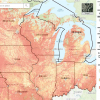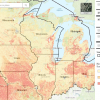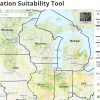Description
Subirrigation is the application of irrigation water below the ground surface to raise the water table to within or near the root zone. In areas with subsurface tile drainage, the same drains that remove excess water during wet periods can be used to provide supplemental irrigation to the crops during dry periods of the year. Potential subirrigation suitability maps are developed using numerical suitability criteria and the Gridded Soil Survey Geographic (gSSURGO) database. Numeric criteria were developed for land use, natural drainage class, saturated hydraulic conductivity, and representative slope to determine the potential suitability for subirrigation, and identify limiting factors for locations across the Midwest. Suitable land uses included cropland and pasture/hay from the National Land Cover Database. Maps are viewable through an online tool at https://transformingdrainage.org/tools/subirrigation-suitability-tool/.
Individual state downloads are available in the Supporting Docs tab.
Cite this work
Researchers should cite this work as follows:
- Yu, F.; Frankenberger, J. R.; Ackerson, J. P.; Reinhart, B. D. (2019). Potential Suitability for Subirrigation in the U.S. Midwest. Purdue University Research Repository. doi:10.4231/10ES-AH67
Tags
Notes
Version 1.0 was created using ESRI ArcGIS 10.6, with soil data from the 2019 fiscal year release of gSSURGO with updated date of 20180918, and land cover data from the National Land Cover Database (NLCD 2011 edition at 30m x30m horizontal resolution and amended in 2014).
The dataset can be more easily accessed through the ftp protocol as file 10_4231_10ES-AH67.zip on the PURR's FTP server. For instructions how to access the zip file, see https://purr.purdue.edu/kb/projects/access-datasets-using-ftp-client.



